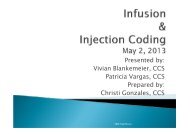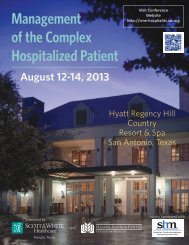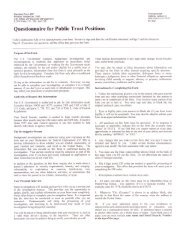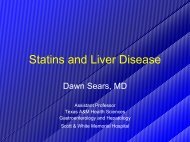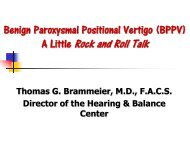Oral Contraceptives/Abnormal Uterine Bleeding in Teenagers
Oral Contraceptives/Abnormal Uterine Bleeding in Teenagers
Oral Contraceptives/Abnormal Uterine Bleeding in Teenagers
- No tags were found...
Create successful ePaper yourself
Turn your PDF publications into a flip-book with our unique Google optimized e-Paper software.
Management of <strong>Abnormal</strong> <strong>Uter<strong>in</strong>e</strong><strong>Bleed<strong>in</strong>g</strong> <strong>in</strong> AdolescentsPamela S. Greene, M.D.Medical Director, Scott & White Hospital Forensic ProgramAssistant Professor, Texas A&M Health Science CenterDepartment of Obstetrics and Gynecology andJo<strong>in</strong>t Appo<strong>in</strong>tment, Department of PediatricsScott and White HealthcareTemple, Texas
Learn<strong>in</strong>g Objectives1. Review term<strong>in</strong>ology and causes ofabnormal uter<strong>in</strong>e bleed<strong>in</strong>g2. Outl<strong>in</strong>e the cl<strong>in</strong>ical evaluation of thepatient with abnormal uter<strong>in</strong>e bleed<strong>in</strong>g3. Discuss treatment options with emphasison extended oral contraceptives
<strong>Abnormal</strong> <strong>Uter<strong>in</strong>e</strong> <strong>Bleed<strong>in</strong>g</strong> (AUB)• It is one of the most common medicalproblems <strong>in</strong> adolescents (12-37%)• It <strong>in</strong>cludes several different types ofbleed<strong>in</strong>g patterns.• The term<strong>in</strong>ologies are not agreed upon.Wilk<strong>in</strong>son, Kadir: Management of <strong>Abnormal</strong> <strong>Uter<strong>in</strong>e</strong> <strong>Bleed<strong>in</strong>g</strong> <strong>in</strong>Adolescents. J Pediatr Adolesc Gynecol (2010) 23:S22-S30
Menorrhagia• Prolonged (more than 7 days) or excessive(greater than 80 ml) uter<strong>in</strong>e bleed<strong>in</strong>goccurr<strong>in</strong>g at regular <strong>in</strong>tervalsHeavy Menstrual <strong>Bleed<strong>in</strong>g</strong> (HMB)• Heavy menstrual blood loss, regardless ofthe pattern of the cycles• Synonymous with hypermenorrheaWilk<strong>in</strong>son, Kadir: Management of <strong>Abnormal</strong> <strong>Uter<strong>in</strong>e</strong> <strong>Bleed<strong>in</strong>g</strong> <strong>in</strong>Adolescents. J Pediatr Adolesc Gynecol (2010) 23:S22-S30
Polymenorrhea: Frequent irregularbleed<strong>in</strong>g at less than 18-day <strong>in</strong>tervals.Oligomenorrhea: Infrequent irregularbleed<strong>in</strong>g at <strong>in</strong>tervals of more than 45days.Metrorrhagia: Intermenstrual bleed<strong>in</strong>gbetween regular periods.
Dysfunctional <strong>Uter<strong>in</strong>e</strong> <strong>Bleed<strong>in</strong>g</strong>Excessive, prolonged orunpatterned bleed<strong>in</strong>g from theuter<strong>in</strong>e endometrium that isunrelated to anatomic lesionsof the uterus.
Dysfunctional <strong>Uter<strong>in</strong>e</strong> <strong>Bleed<strong>in</strong>g</strong>• The most common cause of DUB isanovulation secondary to a disturbance ofthe normal hypothalamic-pituitary-ovarianaxis.• ACOG considers DUB synonymous withanovulatory uter<strong>in</strong>e bleed<strong>in</strong>g.
Anovulation• The adolescent female often hasanovulatory cycles for the first 2-4 years.• Anovulation is the most common cause ofAUB <strong>in</strong> adolescents.Wilk<strong>in</strong>son, Kadir: Management of <strong>Abnormal</strong> <strong>Uter<strong>in</strong>e</strong> <strong>Bleed<strong>in</strong>g</strong> <strong>in</strong>Adolescents. J Pediatr Adolesc Gynecol (2010) 23:S22-S30
Anovulation• No cyclic production of progesterone• A state of unopposed estrogen occurs• The endometrial l<strong>in</strong><strong>in</strong>g becomesabnormally thickened• Spontaneous superficial breakage of l<strong>in</strong><strong>in</strong>gresults <strong>in</strong> asynchronous bleed<strong>in</strong>g
Differential Diagnosis of <strong>Abnormal</strong><strong>Uter<strong>in</strong>e</strong> <strong>Bleed<strong>in</strong>g</strong> (AUB)• <strong>Bleed<strong>in</strong>g</strong> (coagulation) disorders• Medications• <strong>Uter<strong>in</strong>e</strong> polyps or myomas• Trauma / sexual assault• Foreign body
Differential Diagnosis of AUB• Pregnancy: abortion, ectopic, GTD• Genital tract <strong>in</strong>fection• Neoplasms of the genital tract• Endocr<strong>in</strong>e disorders
Endocr<strong>in</strong>e Disorders• Anovulation• Polycystic ovariansyndrome• Hyperprolact<strong>in</strong>emia• Thyroid disorder
<strong>Bleed<strong>in</strong>g</strong> (Coagulation) Disorders• Prevalence rates range from 7to 48% of adolescents withheavy menstrual bleed<strong>in</strong>g• Low threshold for screen<strong>in</strong>gWilk<strong>in</strong>son, Kadir: Management of <strong>Abnormal</strong> <strong>Uter<strong>in</strong>e</strong> <strong>Bleed<strong>in</strong>g</strong> <strong>in</strong>Adolescents. J Pediatr Adolesc Gynecol (2010) 23:S22-S30
<strong>Bleed<strong>in</strong>g</strong> (Coagulation) Disorders:• Von Willebrand disease• Immune thrombocytopenicpurpura or platelet functiondefects
History• Age of menarche; Last menstrual period• Menstrual <strong>in</strong>terval; Duration of flow• How heavy? (How often does patientchange pad or tampon dur<strong>in</strong>g a schoolday? Is she pass<strong>in</strong>g clots?)• Heavy: chang<strong>in</strong>g a pad every 1-2 hours;>6 pads/day; pass<strong>in</strong>g clots; anemiaWilk<strong>in</strong>son, Kadir: Management of <strong>Abnormal</strong> <strong>Uter<strong>in</strong>e</strong> <strong>Bleed<strong>in</strong>g</strong> <strong>in</strong>Adolescents. J Pediatr Adolesc Gynecol (2010) 23:S22-S30
History• Medications– Contraceptive agents; seizure or psychotropicmedications• Sexual history• <strong>Bleed<strong>in</strong>g</strong> after surgery, wounds or toothextraction
Review of Systems• Hirsutism• Acne• Galactorrhea• Weight changes• <strong>Abnormal</strong> bruis<strong>in</strong>g or bleed<strong>in</strong>g• Stress
Physical Exam<strong>in</strong>ation• Tanner stag<strong>in</strong>g• Weight / BMI• Acne• Hirsutism• Source of bleed<strong>in</strong>g• Foreign body• Pregnancy• Neoplasm
Laboratory Evaluation• CBC, TSH• Pregnancy test, if <strong>in</strong>dicated• PCR (if sexually active)• If patient has hirsutism:– Total testosterone– DHEAS– 17OH Progesterone
Laboratory Evaluation• PT, PTT• Von Willibrand screen if history ofexcessively heavy bleed<strong>in</strong>g or anemia* Do Von Willibrand test<strong>in</strong>g before start<strong>in</strong>ghormone therapy
Management• Tranexamic acid• Comb<strong>in</strong>ed contraceptive hormones• Progest<strong>in</strong>s: pills, <strong>in</strong>jections, implants orLNG-IUS
Comb<strong>in</strong>ed Contraceptive Hormones• Comb<strong>in</strong>ed oral contraceptives (COC)• Transdermal patches• Vag<strong>in</strong>al r<strong>in</strong>gs
Benefits of Comb<strong>in</strong>ed ContraceptiveHormones• Regular, predictable menses• Shorter, lighter menses• Less menstrual pa<strong>in</strong> and premenstrualsymptoms• Can extend pills/r<strong>in</strong>g and space out menses
Concerns of COC• Must remember to take a pill daily• Possible side effects:breakthrough bleed<strong>in</strong>g, weight ga<strong>in</strong>,nausea, headaches, venousthromboembolism
Reasons To Modify The Standard21/7 COC Regimen• Decreases estrogen withdrawalsymptoms dur<strong>in</strong>g the hormone free<strong>in</strong>terval: headaches, bloat<strong>in</strong>g, pelvicpa<strong>in</strong>, & breast tenderness• Helps prevent: endometriosis anemia,ovarian cysts, seizures, etc• ConvenienceSulak et al., Obstet Gynecol 2000, 95:261-6.
Chang<strong>in</strong>g the Standard COCRegimen: Current/Future Ideas1. Shorten the hormone free <strong>in</strong>terval from 7 daysto 3 to 5 days to provide greater ovariansuppression and decrease the<strong>in</strong>cidence/severity of hormone withdrawalsymptoms2. Extend the # of days of active OCs to greaterthan 21 days3. Add estrogen dur<strong>in</strong>g the hormone free <strong>in</strong>terval
Types of COC Use• Cyclic: 21/7 24/4• Extended: 6 weeks on/4 days off or 84/7• Cont<strong>in</strong>uous*Vag<strong>in</strong>al r<strong>in</strong>g can also be used <strong>in</strong> acont<strong>in</strong>uous fashion
Extended COC Regimen:Helpful H<strong>in</strong>ts• When <strong>in</strong>itiat<strong>in</strong>g COCs, beg<strong>in</strong> with thestandard regimen for 3- 4 monthsbecause of high <strong>in</strong>cidence of BTB.• Have patient return dur<strong>in</strong>g the third orfourth cycle to assess compliance &side effects
Extended COC Regimen:Helpful H<strong>in</strong>ts• If patient hav<strong>in</strong>g withdrawal symptomsdur<strong>in</strong>g the hormone free <strong>in</strong>terval or wantsto delay menses, discuss extend<strong>in</strong>g theactive pills.• Instruct to extend active pills to 6-9 weeksor until BTB occurs; take a 3- 4 dayhormone free <strong>in</strong>terval and restart (relabelpack to correct day of week).
Extended COC Regimen:Helpful H<strong>in</strong>ts• Or do cont<strong>in</strong>uous pill regimen (see<strong>in</strong>structions- “Rule of 3’s”)• Make sure your patient understandsand is comfortable with this extendedor cont<strong>in</strong>uous regimen; if not, usestandard regimen or 84/7 COC
Extended COC Regimen:Negatives• Increases counsel<strong>in</strong>g time <strong>in</strong> theoffice; your patient mustunderstand how to extend• Side effects?? - no extensivedata; studies underway
Extended COC Regimen:Negatives• Possibly <strong>in</strong>creased cost because moreactive weeks per year (prescribe 3months at a time/4 packs)• Some <strong>in</strong>surances/pharmacy will onlygive patient one pack at a time• Confus<strong>in</strong>g for some patients
Extended COC Regimen:Negatives• Increased lifetime steroid use, but notheoretical reason to anticipate <strong>in</strong>creasedcomplications (i.e. DVT, MI, stroke, etc.);no extensive data• No reported <strong>in</strong>crease <strong>in</strong> complications;extended regimens used for decades <strong>in</strong>patients with endometriosis
Which pill do I pick?If heavy, prolonged or pa<strong>in</strong>ful bleed<strong>in</strong>g:COC with a strong progest<strong>in</strong>-Levonorgestrel or NorgestrelIf acne, hirsuitism, weight concerns, PMDD:COC with a less androgenic progest<strong>in</strong>-Desogestrel or Drosper<strong>in</strong>one
COC-strong progest<strong>in</strong>sOrig<strong>in</strong>al BrandNameBranded GenericNamesEth<strong>in</strong>ylEstradiolProgest<strong>in</strong> (mg)RegimenNordetteLevora30Levonorgestrel 0.1521/7LevlenPortiaAlesseLevlite20Levonorgestrel 0.121/7AvianeLess<strong>in</strong>aLuteraSronyxSeasonaleQuasense3084/7JolessaLevonorgestrel 0.15SeasoniqueIntera3084/7 EELo/OvralLow-Ogestrel3021/7CryselleNorgestrel 0.3
COC-medium strength progest<strong>in</strong>sOrtho-NovumNecon 1/353521/7Nortel 1/35Nor<strong>in</strong>yl 1+35Noreth<strong>in</strong>drone 1ModiconBrevicon3521/7Necon 0.5/35Noreth<strong>in</strong>drone 0.5Nortel 0.5/35Ortho Novum 777Ovcon-35Femcon FE (chewable)Balziva3535Noreth<strong>in</strong>drone 0.421/721/7 (with iron)Loestr<strong>in</strong> Fe 1/20Junel Fe 1/202021/7 (with iron)Microgest<strong>in</strong> Fe 1/20Noreth<strong>in</strong>drone acetate 1Loestr<strong>in</strong> 24 Fe2024/4 (with iron)Loestr<strong>in</strong> Fe 1.5/30Junel Fe 1.5/3030Noreth<strong>in</strong>drone acetate 1.521/7 (with iron)Microgest<strong>in</strong> Fe 1.5/30Demulen 1/35Kelnor 1/35Zovia 1/3535Ethynodiol diacetate 121/7Ortho-CyclenSpr<strong>in</strong>tecMononessa35Norgestimate 0.2521/7
COC-less androgenic progest<strong>in</strong>sOrig<strong>in</strong>al Brand NameBrandedGeneric NamesEth<strong>in</strong>ylEstradiolProgest<strong>in</strong> (mg)RegimenDesogenApri3021/7Ortho-CeptReclipsenDesogestrel 0.15SoliaMircetteKariva2021/2/5 EE10 mcgAzuretteYasm<strong>in</strong>Ocella3021/7Drosper<strong>in</strong>one 0.3YazGianvi2024/4
Other Progest<strong>in</strong>s that alter menstrualbleed<strong>in</strong>g• LNG-IUS• Depot medroxyprogesterone acetate(DMPA)• Levonorgestrel implants• Progesterone only oral contraceptives
Levonorgestrel Intrauter<strong>in</strong>e System(LNG IUS)Steroidreservoir32 mmlevonorgestrel20 mcg/day
LNG IUS: Percentage Reduction ofMenstrual Blood Loss0-25LNG IUSPlacebo-50-75Prostagland<strong>in</strong>Synthetase InhibitorComb<strong>in</strong>ation OCs-100Milsom et al. Am J Obstet Gynecol 1991;164:879
LNG IUS Counsel<strong>in</strong>g: Changes <strong>in</strong><strong>Bleed<strong>in</strong>g</strong>• <strong>Bleed<strong>in</strong>g</strong> characteristics:• 1 – 4 mo frequent spott<strong>in</strong>g• 1 – 6 mo reduced duration and amount ofbleed<strong>in</strong>g• Reduction <strong>in</strong> menstrual blood loss• After 12 mo, about 20 % have no bleed<strong>in</strong>gPakar<strong>in</strong>en et al. Fertil Steril 1997;68:59
LNG IUS Counsel<strong>in</strong>g: Absence of<strong>Bleed<strong>in</strong>g</strong>• Local effect– No proliferation of endometrium• This is expected. It is not a sign of:– Pregnancy– Ovarian or pituitary dysfunction– Menopause• Rapid return to menstruation after removal
LNG IUS: Endometrial EffectMonthsOvulationDays of cycleChanges <strong>in</strong> the endometrium dur<strong>in</strong>g normal menstrual cycle
LNG IUS: Endometrial EffectMonthsOvulationDays of cycleEndometrium <strong>in</strong> “rest<strong>in</strong>g state” with LNG IUS
DMPA Intramuscular Injections• Menstrual changes occur <strong>in</strong> almost allusers• Most experience unpredictable bleed<strong>in</strong>gpatterns <strong>in</strong> first few months of use• With cont<strong>in</strong>ued use, frequency and lengthof bleed<strong>in</strong>g episodes decreases with mostbecom<strong>in</strong>g amenorrheic over time
<strong>Bleed<strong>in</strong>g</strong> Patterns In DMPA Users100%80%60%40%20%11-308-101-700%3 9 15 21 27 33 39 45 54 60 66MonthFertil Steril 1973; 24:331
Levonorgestrel Implants• Menstrual changes occur <strong>in</strong> almost allwomen• Dur<strong>in</strong>g the first year, the majority (2/3’s)experience irregular bleed<strong>in</strong>g with therema<strong>in</strong>der hav<strong>in</strong>g regular menses (1/4) oramenorrhea (about 10%)• Over 5 years of use, the majority eventuallyresume a regular bleed<strong>in</strong>g pattern
<strong>Bleed<strong>in</strong>g</strong> Patterns <strong>in</strong> Norplant Users706050403020Regular CyclesIrregualr CyclesAmenorrhea100Year 1 Year 2 Year 3 Year 4 Year 5Obstet Gynecol 1991; 77: 256
Progest<strong>in</strong> Only <strong>Oral</strong> ContraceptiveOrig<strong>in</strong>al BrandNameBranded GenericNamesProgest<strong>in</strong>Regimencont<strong>in</strong>uousNoreth<strong>in</strong>droneCamila0.35Err<strong>in</strong>0.35Micronor0.35Nor-Q-D0.35JolivetteNorgestrelOvrette0.075
Conclusion1. AUB <strong>in</strong> adolescents is a common problem.2. The <strong>in</strong>itial evaluation of the patient can bestarted by the pediatrician.3. Treatment can be <strong>in</strong>itiated with acomb<strong>in</strong>ed oral contraceptive <strong>in</strong> a cyclicmanner.4. Extended or cont<strong>in</strong>uous COC is the mostcommon treatment, but LNG-IUS is alsobe<strong>in</strong>g used <strong>in</strong> certa<strong>in</strong> situations.
STOP HERE
Trends <strong>in</strong> HRTTraditional HRTregimensMore recent HRTregimens! Days 1-25 ! Cont<strong>in</strong>uousestrogenestrogen withcyclic progest<strong>in</strong>! Days 16-25 ! Cont<strong>in</strong>uousprogest<strong>in</strong>comb<strong>in</strong>ed! Days 26-31no meds
Trends <strong>in</strong> <strong>Oral</strong> <strong>Contraceptives</strong>Traditional OCMore recent OCregimensregimens! Days 1-21 EE+P ! Less hormone free days! Days 22-28 Placebo ! Extended regimen! Shift to lower doses ! New progest<strong>in</strong>sof estrogen! Shift to lessandrogenic progest<strong>in</strong>s
Contraceptive Effects on Menstruation:SUMMARY• Most women prefer lighter, less frequentmenses• Current and future contraceptive methodswill favorably affect menstruation• Counsel<strong>in</strong>g regard<strong>in</strong>g alterations <strong>in</strong>menstruation will be critical to <strong>in</strong>itiation andcont<strong>in</strong>uation of these contraceptivemethods
Contraceptive Effects onMenstruation: Elim<strong>in</strong>ation ofMonthly MensesPatricia J. Sulak, M.D.ProfessorTexas A&M College of Medic<strong>in</strong>eDirector, Division of Ambulatory CareDepartment of Ob/GynDirector, Scott and White Sex Education ProgramScott and White Cl<strong>in</strong>ic/Hospital, Temple, Texas
Which BCP?Necon 1/35 (generic) Estrogen 35 mcg; medium strengthNoreth<strong>in</strong>drone 1 mgDesogen Estrogen 30 mcg; low progest<strong>in</strong>desogestrel 0.15 mgMircette Estrogen 20 mcg; low estrogendesogestrel 0.15 mg(and 5 days of estrogen only 10 mcg)Nordette (generic) Estrogen 30 mcg; strong progest<strong>in</strong>levonorgestrel 0.15 mcgYasm<strong>in</strong> Estrogen 30 mcg; low progest<strong>in</strong>drosper<strong>in</strong>one 3 mg
Is Monthly Menstruation Natural???• Late menarche• Early childbear<strong>in</strong>g• High parity• Prolongedbreastfeed<strong>in</strong>g• Early menopauseVS• Early menarche• Late childbear<strong>in</strong>g• Low parity• Shortenedbreastfeed<strong>in</strong>g• Late menopause
Why Alter Menstruation: Frequency,Duration, Amount• Menstrual Disorders Affect Millions ofReproductive Age Women:– menorrhagia– dysmenorrhea– premenstrual symptomatology– “menstrual” migra<strong>in</strong>es
Problems of IncessantOvulation/<strong>Bleed<strong>in</strong>g</strong>• Anemia• Endometriosis• Ovarian cysts• Ovarian cancer
Is Monthly Menstruation Natural???• Late menarche• Early childbear<strong>in</strong>g• High parity• Prolongedbreastfeed<strong>in</strong>g• Early menopauseVS• Early menarche• Late childbear<strong>in</strong>g• Low parity• Shortenedbreastfeed<strong>in</strong>g• Late menopause
$$ Costs $$ of Monthly Menstruation• Sanitary protection• Medical expenses:– pa<strong>in</strong> meds– office visits– procedures• Lost wages/productivity
Is Monthly Menstruation Natural???• Late menarche• Early childbear<strong>in</strong>g• High parity• Prolongedbreastfeed<strong>in</strong>g• Early menopauseVS• Early menarche• Late childbear<strong>in</strong>g• Low parity• Shortenedbreastfeed<strong>in</strong>g• Late menopause
<strong>Oral</strong> Contraceptive Effectson Menstruation• <strong>Bleed<strong>in</strong>g</strong> duration/quantity decreased• Dysmenorrhea decreased• Regulation of cycle length: predictability
Comb<strong>in</strong>ation <strong>Oral</strong> <strong>Contraceptives</strong>• Standard Regimen:– 21 days of estrogen + progest<strong>in</strong>– 7 hormone free days• Rationale: mimic an average cycle length of28 days• Drawback: monthly hormone withdrawalsymptoms
Hormone Withdrawal Symptoms In<strong>Oral</strong> Contraceptive UsersObjective• Measure the frequency and severityof symptoms dur<strong>in</strong>g the pill free<strong>in</strong>terval compared to the active pill<strong>in</strong>tervalSulak et al., Obstet Gynecol 2000, 95:261-6.
Hormone Withdrawal Symptoms In<strong>Oral</strong> Contraceptive UsersStudy Design• Prospective study of OC users• 69 New Starts: No OC use <strong>in</strong> last 3 months• 193 Current Users: OC use " 12 monthsSulak et al., Obstet Gynecol 2000, 95:261-6.
Hormone Withdrawal Symptoms In<strong>Oral</strong> Contraceptive UsersData Collection• Demographics• Daily calendars to subjectively recordheadaches, pelvic pa<strong>in</strong>, bleed<strong>in</strong>g, analgesicuse, and other symptomatologySulak et al., Obstet Gynecol 2000, 95:261-6.
Hormone Withdrawal Symptoms <strong>in</strong><strong>Oral</strong> Contraceptive Users21 active7 hormonefreep valuePelvic pa<strong>in</strong>21%70%
Hormone Withdrawal Symptoms In<strong>Oral</strong> Contraceptive UsersHeadaches• Headaches were more frequentand more severe dur<strong>in</strong>g thehormone free <strong>in</strong>terval95:261-6.Sulak et al., Obstet Gynecol 2000,
Frequency of Headaches100[A]80CURRENT USERSPERCENT60402010080[B]NEW STARTS0Active PillActive PillPERCENT6040200Active PillActive PillActive Pill(Sulak et al.; Obstet Gynecol 2000; 95:261-6)6)
Hormone Withdrawal Symptoms In<strong>Oral</strong> Contraceptive UsersPelvic Pa<strong>in</strong>/Cramps• Pelvic pa<strong>in</strong>/cramps were morefrequent and more severe dur<strong>in</strong>gthe hormone free <strong>in</strong>tervalSulak et al., Obstet Gynecol 2000, 95:261-6.
Frequency of Pelvic Pa<strong>in</strong> and Cramps10080[A]CURRENT USERSPERCENT60402010080[B]NEW STARTS0Active PillActive PillPERCENT6040200Active PillActive PillActive Pill(Sulak et al.; Obstet Gynecol 2000; 95:261-6)6)
Hormone Withdrawal Symptoms In<strong>Oral</strong> Contraceptive UsersBloat<strong>in</strong>g/Swell<strong>in</strong>g• Bloat<strong>in</strong>g and swell<strong>in</strong>g were morecommon dur<strong>in</strong>g the hormone free<strong>in</strong>terval• Symptoms began <strong>in</strong> the preced<strong>in</strong>g weekprior to the hormone free <strong>in</strong>tervalSulak et al., Obstet Gynecol 2000, 95:261-6.
Frequency of Bloat<strong>in</strong>g and Swell<strong>in</strong>g10080[A]CURRENT USERSPERCENT60402010080[B]NEW STARTS0Active PillActive PillPERCENT6040200Active PillActive PillActive Pill(Sulak et al.; Obstet Gynecol 2000; 95:261-6)6)
Hormone Withdrawal Symptoms In<strong>Oral</strong> Contraceptive UsersBreast Tenderness• Breast tenderness was more commondur<strong>in</strong>g the hormone free <strong>in</strong>terval• Symptoms began <strong>in</strong> the preced<strong>in</strong>g weekprior to the hormone free <strong>in</strong>tervalSulak et al., Obstet Gynecol 2000, 95:261-6.
Frequency of Breast Tenderness10080[A]CURRENT USERSPERCENT60402010080[B]NEW STARTS0Active PillActive PillPERCENT6040200Active PillActive PillActive Pill(Sulak et al.; Obstet Gynecol 2000; 95:261-6)6)
Extend<strong>in</strong>g the Duration of Active <strong>Oral</strong> Contraceptive Pills toManage Hormone Withdrawal SymptomsObjective• Test the hypothesis that extend<strong>in</strong>g thenumber of consecutive active OCs willdecrease the frequency of menstrualrelated problemsSulak et al., Obstet. Gynecol. 1997; 89: 179-83
Extend<strong>in</strong>g the Duration of Active <strong>Oral</strong>Contraceptive Pills to Manage HormoneWithdrawal SymptomsMethodProspective analysis of 50 patients on OCs whoexperienced hormone withdrawal symptomsdur<strong>in</strong>g the pill free <strong>in</strong>terval and were allowed toextend the number of consecutive active OCsSulak et al., Obstet. Gynecol. 1997; 89: 179-83
Symptoms Dur<strong>in</strong>g the Pill FreeInterval*SymptomsMigra<strong>in</strong>esDysmenorrheaMenorrhagiaPMSOther**TotalRank<strong>in</strong>g of Symptoms*#1 #2 #3 #4 Total48% 14% 6% 8% 76%22% 40% 16% 78%18% 12% 6% 36%12% 10% 10% 32%6%100% 82% 38% 8%*Most patients reported more than one symptom+ most severe symptoms** Acne, endometriosis, recurrent vuvular cystsSulak et al., Obstet. Gynecol. 1997; 89: 179-83
Method of Extend<strong>in</strong>g Numberof Active Weeks• Instructed to take 6 consecutive weeks ofactive OCs followed by a hormone free week• The <strong>in</strong>terval of active pills was <strong>in</strong>creased by3 weeks each consecutive cycle (6 wks, 9wks, 12 wks), followed by a hormone freeweek• If a patient experienced <strong>in</strong>tolerable sideeffects, she rema<strong>in</strong>ed on the regimen thatworked best for herSulak et al., Obstet. Gynecol. 1997; 89: 179-83
Study Results of the 50 Patients*• 37 patients (74%) stabilized on an extendedregimen– 6 week 8– 9 week 13– 12 week 16• 13 patients (26%) not stabilized on anextended regimen– Most common reasons– Breakthrough bleed<strong>in</strong>g– Breakthrough spott<strong>in</strong>g– Headaches*All patients were on a low dose monophasic pillSulak et al., Obstet. Gynecol. 1997; 89: 179-83
Menstrual Reduction With Extended Use ofComb<strong>in</strong>ation OCPs: Randomized Controlled Trial• 90 patients randomized to 21/7 day versus42/7 day regimen of a 30 mcg monophasicOC• 59% completed the 48 week study• The 42/7 day regimen resulted <strong>in</strong> fewerbleed<strong>in</strong>g days and no <strong>in</strong>crease <strong>in</strong> meanspott<strong>in</strong>g days or bleed<strong>in</strong>g episodesMiller L, Notter K: Obstet Gynecol 2001; 98: 771 - 778
Acceptance of Alter<strong>in</strong>g the Standard 21day/7 day <strong>Oral</strong> Contraceptive Regimen toDelay Menses and Reduce HormoneWithdrawal SymptomsPatricia J. Sulak, M.D., Thomas J. Kuehl, Ph.D.,Miriam Ortiz, R.N., and Bobby L. Shull, M.D.Am J Obstet Gynecol 2002; 186: 1142-9
Study Design• Retrospective review of patients on 30-35 mcg OCs withhormone withdrawal symptoms dur<strong>in</strong>g the hormone free<strong>in</strong>terval, offered alterations to their 21/7 day regimen• Electronic medical record search of the phrase“extend<strong>in</strong>g the number of active pills” by Patricia J.Sulak, M.D.• Initial counsel<strong>in</strong>g was between December 93 andOctober 2000• Counseled on <strong>in</strong>creas<strong>in</strong>g the number of active pills +/-decreas<strong>in</strong>g the number of hormone free days
Results• 318 counseled on “extend<strong>in</strong>g the number ofactive pills”• 292 had follow up• 26 lost to follow up• hormone withdrawal symptoms: headache,dysmenorrhea, menorrhagia, premenstrualsymptomatology
Reasons For Extend<strong>in</strong>g Active PillsHeadacheDysmenorrheaHypermenorrheaPremenstrual SxsOther ***(292 Patients)Primary Reason*35%21%19%13%12%% with Sx**46%41%30%22%100%* most severe symptom, ** most had more than one Sx*** convenience, endometriosis, acne
Characteristics of the 292 Patients• Average age 35.4 with 101 age 40 or greater• Patients cit<strong>in</strong>g dysmenorrhea were younger• Patients cit<strong>in</strong>g menorrhagia had a greaterBMI
Results of 292 Patients# %I: Did not extend 25 9II: Extended then D/Ced OCs 57 19III: Extended then returned to 21/7 38 13IV: Cont<strong>in</strong>u<strong>in</strong>g to extend 172 59292 100
Group I: Chose Note To Extend[25 patients (9%)]Reasons: Preference for monthly mensesSymptoms not severe enoughFears/concernsBTB on current 21/7 regimenIncreased cost of pills
Group II: Extended,then discont<strong>in</strong>ued OCs[57 patients (19%)]Reasons: Desire for pregnancySterilizationBecame menopausalPelvic surgery <strong>in</strong>clud<strong>in</strong>g hysterectomyNo longer sexually activeWorsen<strong>in</strong>g of numerous symptomsCost of pills
Group III: Extended,then returned to 21/7[38 patients (13%)]Reasons: <strong>Bleed<strong>in</strong>g</strong> issues: BTB, BTSSide EffectsFear/concernsIncreased costs
Group IV: Cont<strong>in</strong>u<strong>in</strong>g to extend[172 patients (59%)]• typical pattern was 12 # 12 (mean # SD) weeksof active pills with a median of 9 weeks and arange up to 104 weeks• typical pill-free <strong>in</strong>terval was 6 # 2 days with amedian of 5 days and a range of 0 to 7; 46%reported




